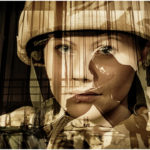Women, PTSD, and Veterans
By: Barbara L. Lynn
           According to Linda Schwartz, whom is the author of Women in the Military and Women Veterans reported, “Military women have much higher rates of suicide than civilian women in America. Army women were also found to have less death from disease but were more likely to become the victims of homicides, suicides, and/or accidents than civilian women.â€
            Patricia A. Resnic’s Cognitive Processing Therapy (CPT) for Rape-Related PTSD and Depression states, “If PTSD occurs with one-time assault victims, it would seem reasonable to expect that it would be all the more likely to occur for military veterans, who have experienced an even greater number of traumatic occurrences both in frequency and intensity or who have experienced a potentially life- threatening experience over a period of time, even if nothing life-threatening ever happened. This is not to denigrate the experience of assault victims. It is only to provide some perspective about PTSD in the veteran population.
 CPT focuses primarily on ‘cognitions’ – coming to know through both awareness and judgment. The sessions include “components which help the client to:
- access her memory of the event,
- identify and experience her emotions, until they have been extinguished,
- identify and challenge (her) beliefs about the event itself and beliefs about herself and the rape.â€
The focus in the therapy increasingly shifts from recognizing and naming events, thoughts, and feelings around the traumatic issue to skill development in challenging the clients’ beliefs as well as cognitive patterns.
It is noteworthy that, while depression is mentioned once as possibly accompanying PTSD symptoms, nothing in the CPT limited twelve sessions model is outlined as specifically targeting the issue of depression.
It is reasonable for us to consider the following question: Where would our veteran population currently dealing with PTSD be now (as well as those who are deceased directly or indirectly as a result of PTSD) had they been, upon discharge:
- informed about the nature and symptoms of PTSD and depression;
- informed that PTSD and depression are, if not a “normal†response to the circumstances they had just been through, at least not an abnormal response;
- Offered a 12- week course of treatment and skill-building techniques specifically tailored to their war experiences and resulting symptoms.

